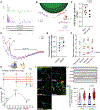The integrated stress response effector GADD34 is repurposed by neurons to promote stimulus-induced translation
- PMID: 38219147
- PMCID: PMC10964249
- DOI: 10.1016/j.celrep.2023.113670
The integrated stress response effector GADD34 is repurposed by neurons to promote stimulus-induced translation
Abstract
Neuronal protein synthesis is required for long-lasting plasticity and long-term memory consolidation. Dephosphorylation of eukaryotic initiation factor 2α is one of the key translational control events that is required to increase de novo protein synthesis that underlies long-lasting plasticity and memory consolidation. Here, we interrogate the molecular pathways of translational control that are triggered by neuronal stimulation with brain-derived neurotrophic factor (BDNF), which results in eukaryotic initiation factor 2α (eIF2α) dephosphorylation and increases in de novo protein synthesis. Primary rodent neurons exposed to BDNF display elevated translation of GADD34, which facilitates eIF2α dephosphorylation and subsequent de novo protein synthesis. Furthermore, GADD34 requires G-actin generated by cofilin to dephosphorylate eIF2α and enhance protein synthesis. Finally, GADD34 is required for BDNF-induced translation of synaptic plasticity-related proteins. Overall, we provide evidence that neurons repurpose GADD34, an effector of the integrated stress response, as an orchestrator of rapid increases in eIF2-dependent translation in response to plasticity-inducing stimuli.
Keywords: BDNF; CP: Molecular biology; CP: Neuroscience; GADD34; cytoskeleton; eIF2α; local translation; mRNA translation; neuron; neuronal plasticity; protein synthesis; synaptic plasticity.
Copyright © 2024 The Authors. Published by Elsevier Inc. All rights reserved.
Conflict of interest statement
Declaration of interests The authors declare no competing interests.
Figures







References
Publication types
MeSH terms
Substances
Grants and funding
LinkOut - more resources
Full Text Sources
Molecular Biology Databases
Miscellaneous

